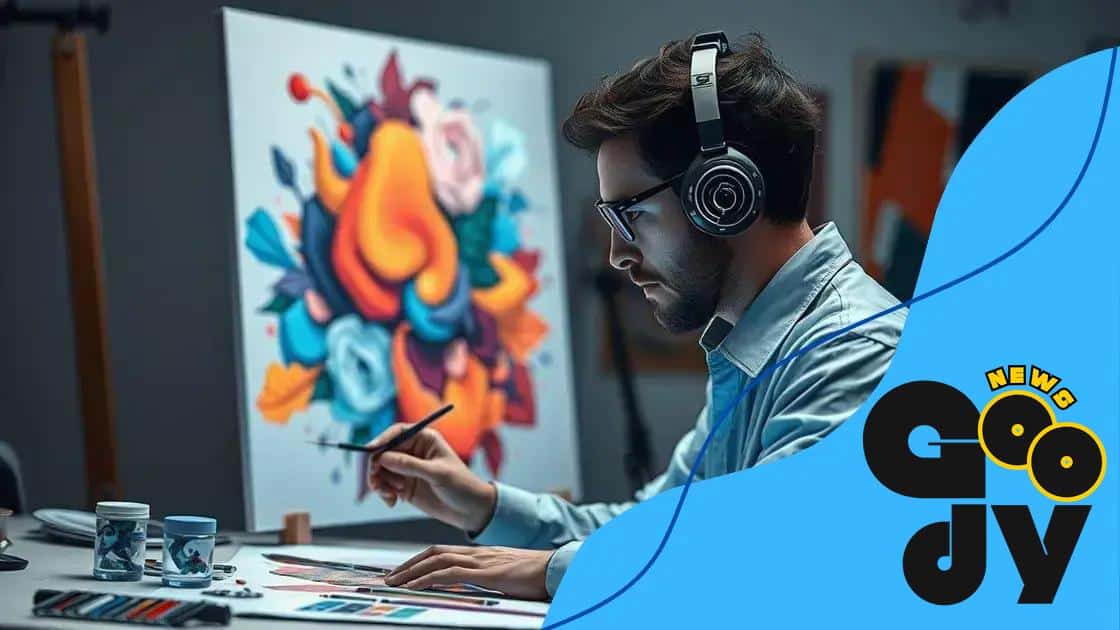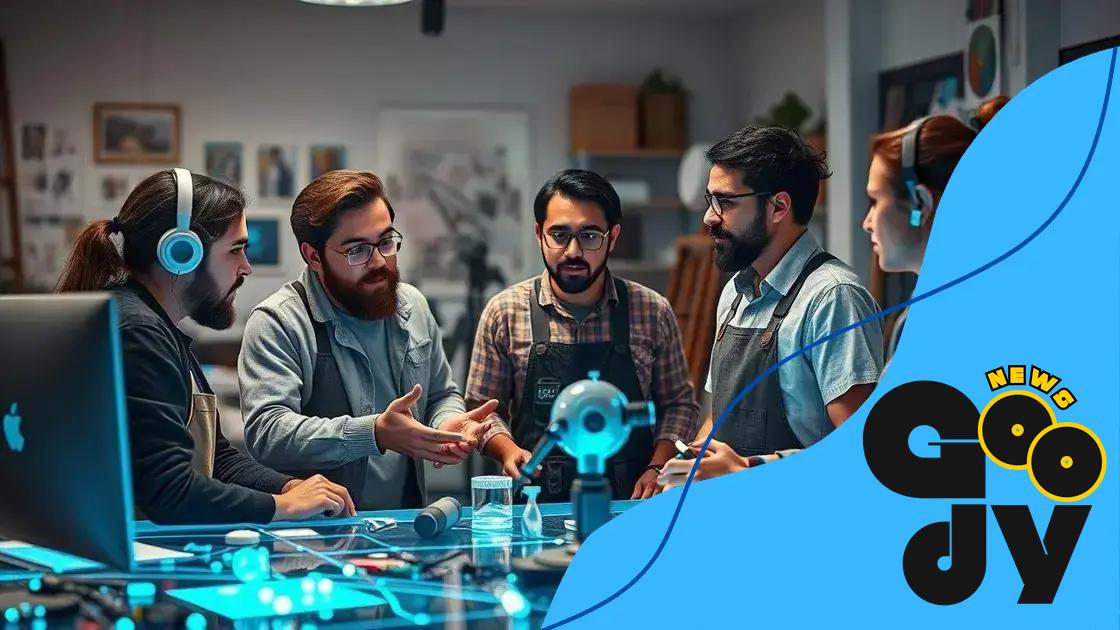The role of AI in transforming the creative industries

The role of AI in transforming the creative industries involves enhancing artistic expression, streamlining workflows, and democratizing art creation, allowing artists to collaborate with technology for innovative outcomes.
The role of AI in transforming the creative industries is increasingly significant. Have you ever wondered how artificial intelligence influences artists and designers? Let’s dive into this fascinating topic.
Understanding AI’s impact on creativity
Understanding AI’s impact on creativity is essential as it changes how we create and innovate. Technology has always influenced artistic expression, but now with AI, the landscape is shifting dramatically.
AI helps artists in various ways, making their creative processes more efficient. For instance, AI algorithms can analyze trends and suggest colors and styles, enabling artists to explore new avenues.
How AI Enhances Creative Processes
AI tools can assist in generating ideas, allowing artists to experiment freely. This technology can adapt to an artist’s style or suggest combinations that a human might not consider.
- Facilitates brainstorming sessions by generating multiple ideas.
- Offers instant feedback on designs and concepts.
- Simplifies repetitive tasks, freeing artists to focus on their vision.
As AI technology evolves, it fosters collaboration between human creativity and machine learning. Artists can use AI to enhance their skills and explore possibilities that might be beyond their natural capabilities.
Challenges in Embracing AI
Despite its benefits, integrating AI into creative work brings challenges. Some artists worry about losing their unique touch or becoming overly reliant on technology. It’s crucial to find a balance where AI serves as an assistant rather than a replacement.
Ultimately, the key lies in understanding that AI can complement human creativity. Embracing this technology can lead to innovative artistic expressions that blend human talent and computational power.
AI tools revolutionizing artistic expression
AI tools are changing how artists create and express their ideas. These innovative technologies assist in various stages of the artistic process, from conception to execution.
One of the most remarkable aspects of AI is its ability to analyze data and generate new concepts. Artists can use this information to inspire their work and explore uncharted creative paths.
Popular AI Tools for Artists
Many AI tools are currently available, each designed to enhance different elements of art-making. Some popular options include:
- DeepArt – This tool transforms photos into beautiful artwork by applying the styles of famous painters.
- Daz 3D – Users can create stunning 3D models, which can serve as a base for illustrations and animations.
- Runway ML – An advanced AI platform that allows artists to create, edit, and manipulate video and images in innovative ways.
These tools empower artists to push their boundaries and think outside the box. They provide a blend of technology and creativity that opens up new horizons.
The Impact of AI on Different Art Forms
AI’s influence is felt across various art forms, such as painting, music, and writing. For instance, musicians use AI to compose music and generate unique melodies, while writers utilize AI for brainstorming and idea generation.
Furthermore, visual artists traditionally relied on manual techniques. With AI, they can explore new methods, creating vibrant pieces that seamlessly merge technology with human touch. This fusion showcases the endless possibilities when embracing AI technology.
Challenges faced by creatives in adopting AI

While AI offers many benefits in the creative process, it also poses challenges for artists and creators. Adopting AI technology can be both exciting and daunting.
Many artists fear that using AI may dilute their unique voice. They worry that technology could replace their intuition and originality, leading to uniformity in art. This concern is valid, as artists have historically relied on personal experiences and emotions to drive their work.
Common Concerns Among Creatives
Some of the most common challenges faced by artists when integrating AI include:
- Loss of individuality in their artwork.
- Fears about job security as AI continues to evolve.
- Complexity of learning and adapting to new tools.
- Concerns about ethical implications of using AI-generated content.
The anxiety surrounding the role of AI can be overwhelming. Artists often question whether their work will still be considered authentic when influenced by algorithms. This hesitation can lead to resistance in adopting AI as a creative partner.
Navigating the AI Landscape
Moving forward requires understanding the balance between human creativity and machine learning. Artists can embrace AI as a tool to enhance their skills rather than a crutch that stifles their creative spirit. By approaching AI with an open mind, they may discover new dimensions to their art.
Artists can also engage in communities that focus on merging technology with creativity. Collaborating with like-minded individuals helps build confidence and knowledge around using AI effectively.
Case studies of AI in design and media
Several case studies illustrate the transformative power of AI in design and media. These examples showcase how artists and designers are leveraging AI tools to enhance their work and reach audiences more effectively.
One notable case is the collaboration between AI and graphic designers at Adobe. Their AI-powered tool, Adobe Sensei, analyzes vast amounts of design data to suggest layout improvements and color schemes. This integration allows designers to streamline their creative process, making it easier to produce high-quality work in less time.
AI in Film Production
In film, AI is being used to analyze scripts and predict audience engagement. For example, the production team behind the movie “Morgan” used AI to assess how audiences might react to different plot twists. This data-driven approach helped them tailor the narrative to better meet audience expectations.
- AI tools can analyze scripts for pacing and character development.
- They provide insights on casting choices based on audience perceptions.
- Advanced algorithms can forecast box office success by analyzing trends and demographics.
These examples demonstrate how AI is revolutionizing not only the creative process but also the business side of media and design.
Innovations in Graphic Design
Another fascinating example comes from Canva, an online design platform that utilizes AI to help users create stunning visuals effortlessly. Canva’s AI-powered features suggest templates and design elements personalized to the user’s needs, making it accessible even to those without formal design training.
Additionally, artists are experimenting with AI-generated art through tools like DALL-E and Artbreeder. These platforms allow users to create unique images using machine learning, pushing the boundaries of traditional art.
The future of creativity with AI technology
The future of creativity is bright with AI technology leading the way. As AI continues to evolve, it promises to bring innovations that can transform how artists interact with their craft.
This transformation will create possibilities that were once thought impossible. With AI, artists can explore new styles, techniques, and mediums. They can experiment without boundaries, using AI as a collaborative partner in the creative process.
Emerging Trends in AI-Enhanced Creativity
We are already seeing exciting trends in how AI is shaping the creative landscape. Some key trends include:
- Personalized Art Creation – AI systems can analyze personal tastes, helping to create artwork that resonates more with individual viewers.
- AI-Generated Music – Musicians are using AI to compose new melodies and rhythms, often blending genres in unique ways.
- Interactive Storytelling – AI tools allow creators to develop dynamic narratives that adapt based on audience interaction.
- Collaborative Design Platforms – Tools that enable multiple artists to collaborate with AI input, fostering a community-driven creative process.
These advancements reflect a world where technology does not replace human creativity but enhances it. Artists can focus more on the imaginative aspects while AI handles repetitive tasks.
A New Era of Accessibility
AI technology is also making art more accessible. Platforms equipped with AI can simplify the process of creation, allowing anyone to express their ideas visually or musically. This democratization of creativity enables a broader range of voices to contribute to the art world.
Moreover, educational tools powered by AI can help aspiring artists develop their skills more efficiently. With personalized feedback and learning paths, students can reach their artistic aspirations faster than ever before.
FAQ – Frequently Asked Questions about AI in the Creative Industries
How does AI enhance the creative process?
AI enhances the creative process by offering artists new tools to explore their ideas, streamline their workflows, and experiment with unique styles and techniques.
What are some challenges artists face when adopting AI?
Artists often worry about losing their unique voice, job security, and the complexity of learning new AI tools which might hinder their creativity.
Can AI make art more accessible to non-artists?
Yes, AI tools simplify the creation of art, enabling anyone, regardless of skill level, to express their ideas visually or musically.
What are examples of AI tools currently used in the creative industries?
Popular AI tools include Adobe Sensei for design enhancements, DALL-E for generating unique images, and tools like Canva for simplifying graphic design.





